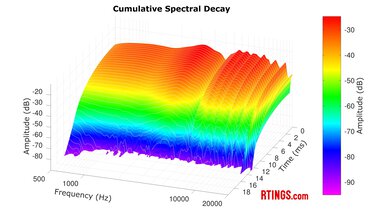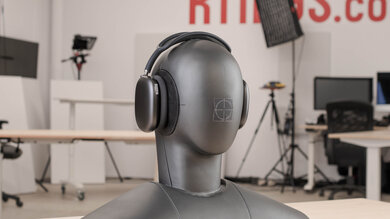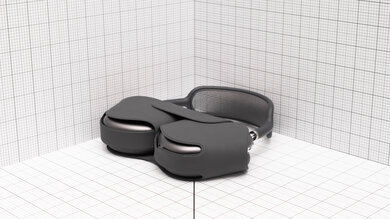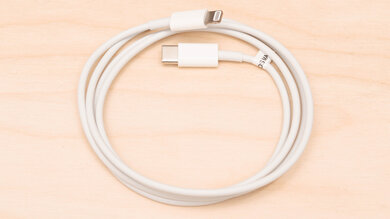The Apple AirPods Max are Apple's first pair of wireless over-ear headphones. Unlike other Apple headphones, like the Apple AirPods Pro, which only come in one sleek, white plastic colorway, these over-ears have an aluminum frame with knit padding that comes in several different colors. That said, you can still expect a premium design as well as a powerful noise cancelling (ANC) experience. They also have an adaptive EQ, so the headphones automatically adjust their sound based on the unique shape of your ears, and their H1 chip is great for easy pairing with all of your iOS/iPadOS devices. Unfortunately, there have been a few user issues with build quality. You can't turn the headphones off either, and you can read more about this in our Battery test.
Our Verdict
The Apple AirPods Max are adequate for sports and fitness. Since they're over-ears and made of metal, they're fairly heavy and not very portable. While they're stable enough for upright movements, like pull-downs, they're not necessarily going to stay put if you benchpress or sprint. Their sound profile gives your music a balanced tuning with a warm top-end. Their wireless Bluetooth design ensures cables won't catch on equipment, and if you want ANC to quiet the noise of other people at the gym, it performs very well.
- Great build quality.
- H1 chip for seamless pairing with Apple devices.
- Heavy, bulky design which can be fatiguing to wear.
- Mediocre breathability.
The Apple AirPods Max are great for travel. Their noise isolation is incredible at cutting out environmental noises to make planes, trains, and automobiles quieter. The battery life easily lasts through intercontinental flights without a recharge. It has a sound profile that offers a smooth and weighty bass, an even mid-range, and a warm treble that suits most music genres and movies. They feel decently comfortable, though they're a bit heavy and not very portable.
- Outstanding noise cancelling.
- Great build quality.
- Excellent continuous battery life.
- H1 chip for seamless pairing with Apple devices.
- Heavy, bulky design which can be fatiguing to wear.
- Mediocre breathability.
The Apple AirPods Max are good for office work. Their adaptive noise cancellation does a remarkable job of attenuating keyboard clatter, chit-chat, and ambient din. They're decently comfortable to wear with a long battery life that can last a couple of workdays without a recharge. The sound signature reproduces your audio with a good amount of low-end weight, clear mids, and a warm treble response. Unfortunately, the microphone system and the noise handling struggle to capture your voice accurately and cut out other sounds in the background during a call.
- Outstanding noise cancelling.
- Great build quality.
- Excellent continuous battery life.
- H1 chip for seamless pairing with Apple devices.
- Mic struggles to separate your voice from background noise.
- Mediocre breathability.
Wired connection disables the microphone.
The Apple AirPods Max headphones are Bluetooth-only headphones and, therefore, limited in terms of compatibility with gaming devices. With an Apple device, the A/V sync is better than on Android devices for ensuring your mobile games match the soundtrack, but their overall mic performance is lacking.
The Apple AirPods Max are satisfactory for wired gaming, but their usefulness is limited because their microphone doesn't work when you use them wired. They also need adapters (sold separately) to connect to most analog jacks. Still, their sound offers a balanced low-end and clear mid-range, with a warm top-end that won't cause early fatigue.
- Great build quality.
Wired connection disables the microphone.
The Apple AirPods Max have great audio reproduction accuracy. They're consistent between different people for the most part, though glasses and long hair can break the over-ear seal and reduce the low bass. Nevertheless, the peaks and dips performance indicate that these headphones produce a smooth sound. Plus, the bass provides oomph without overwhelming the mostly flat mid-range. The treble sounds warm, albeit slightly dull, depending on the pitch, while higher registers are a bit brighter on cymbal hit harmonics.
The Apple AirPods Max are fantastic for noise isolation. The over-ear design seals your ears well to passively isolate out noise, while the adaptive noise cancellation filters out low rumbles and nearby conversation very well. They leak a little, but in most spaces, neighbors won't hear your audio content.
The Apple AirPods Max are middling for microphone performance. While their mic system captures intelligible speech, it struggles to separate your voice from other voices and background racket.
The Apple AirPods Max have very good frequency response consistency. Most people with large or small heads can expect a similar sound experience. However, people with glasses may find the low-bass rolls off because the frames break the headphones' over-ear seal.
Performance Usages
Changelog
-
Updated Oct 30, 2025:
The Battery section was updated to mention the Bose QuietComfort Ultra Headphones (2nd Gen).
-
Updated Oct 10, 2025:
We referenced the Nothing Headphone (1) in the Style box.
-
Updated Sep 22, 2025:
We've rectified an issue that affected the Bass, Mid, and Treble Compliance scoring, as well as Peaks and Dips with these headphones.
-
Updated Jun 18, 2025:
We've updated the review to mention the Sony WH-1000XM6 in Comfort.
Check Price
Differences Between Sizes And Variants
The Apple AirPods Max come in several color variants: 'Space Gray,' 'Sky Blue,' 'Pink,' 'Green,' and 'Silver.' We tested the Space Gray variant with the Lightning port, and you can see its label here. We expect each color variant with the Lightning port to perform similarly to our model. In 2024, Apple replaced the Lightning port with a USB-C port and added new colors ('Purple,' 'Blue,' 'Midnight,' 'Starlight,' and 'Orange'). While we expect similar performance on the USB-C variant as the Lightning model, metrics and performance that directly depend on the USB-C port may differ from our results with the Lightning model.
That said, if you're looking to change up the look of your headphones, you can purchase replacement ear cushions in the aforementioned colors directly from the manufacturer.
If you come across another variant, please let us know in the comments, and we'll update our review.
Popular Headphones Comparisons
The Apple AirPods Max are high-end headphones with a premium design. They're the only over-ear headphones by the brand, though Beats are owned by Apple, the Beats Studio Pro Wireless are a bit brighter with less effective ANC, though they can both use the Apple Spatial Audio feature. Thanks to their Adaptive EQ, the AirPods Max can adjust their sound based on their fit and seal on your head. Their noise cancelling feature is also outstanding, although headphones like the Sony WH-1000XM4 Wireless still have a slight edge in this regard. They don't turn off, though, and putting them in their carrying case only puts them into a very low-power mode, which can be frustrating if you want to stop your battery life from draining.
For more headphones, check out our recommendations for the best noise cancelling headphones, the best headphones for music, and the best over-ear headphones.
The Bose QuietComfort Ultra Headphones Wireless have the edge over the Apple AirPods Max if you own an Android device, and it's a bit closer when it comes to Apple devices. While both headphones have a premium feel, the Bose are significantly more comfortable, and their ANC can block out more background noise. Their battery life is a bit longer, and they support multi-device pairing, so you can stay connected to two devices at a time. Their companion app offers sound customization features to help you tweak their sound. They even support aptX Adaptive, a codec that dynamically adapts to your content, giving you better sound quality or lower latency. The Bose and Apple both have spatial audio features to help your audio sound more immersive, and only the Apple headphones have an H1 chip for seamless pairing with iOS devices.
While the Sony WH-1000XM6 are certified Made for iPhone (MFi), the Apple AirPods Max are still the better option for use in the Apple ecosystem. Although the Sony have better performance in most metrics like noise attenuation, microphone quality, and customizability of both function and sound, the AirPods Max have more replicable audio delivery across individuals and between reseats, making their sound reproduction more predictable and consistent. That said, if you're not in the Apple ecosystem, the AirPods Max probably aren't the pick for you, as you'll lose a lot of functionality. If you're on iOS or running macOS, it's a toss-up between the two products, depending on what you prioritize, though it's worth mentioning that you won't have access to head tracking on the Sony outside of Android.
The Apple AirPods Max and the Sony WH-1000XM5 Wireless are both great headphones with fantastic noise isolation performance. If you're an iOS user, you'll want to check out the Apple headphones. They have an H1 chip for seamless pairing with Apple devices and bass and mid ranges that more closely match our target with a darker top-end. Meanwhile, the Sony headphones are also more customizable, thanks to their companion app, and their battery lasts longer. You can also connect them via Bluetooth or analog without adapters. That said, the Sony are more plasticky.
The Sony WH-1000XM4 Wireless are better headphones than the Apple AirPods Max if you care about customizability. The Sony have a companion app that offers many customization features, including a graphic EQ and presets. They also come with a 1/8" TRS cable if you want to use them wired, and are more comfortable. Both headphones offer a fantastic ANC performance, though the Sony still edge in front of the pack in this regard, as they can block out a bit more sound than the Apple. That said, the Apple are less plasticky and have the H1 Chip to make seamless swaps between Apple devices, and their tuning is less excited-sounding.
Test Results

These headphones use Apple's Adaptive EQ, which adjusts their sound to the fit and seal of the headphones on your head. Using it, they deliver a touch of extra bass compared to our target curve and de-emphasized top-end as of firmware version 6A326. We've also tested their sound via firmware 3C39. They perform very similarly to the original firmware's sound profile. You can see a graph comparison of our results here.
However, whether the ANC is on or off makes a difference in the sound profile, as this effectively turns the Adaptive EQ on or off, respectively. Both the wired and Bluetooth connections have a very similar frequency response when the ANC is on. If you turn the ANC off, there's a minor difference between frequency responses, which is most prominent in the bass and mid ranges. Using Bluetooth reproduces more low bass. You can also see all four passes together here.
While they don't have any built-in EQ presets, if you have a compatible iOS or iPadOS device, you can access a couple of different EQ presets in the 'Accessibility' settings to help you adjust their sound.
The Apple AirPods Max have very good frequency response consistency. While most of the mid-range sounds virtually the same regardless of whether you have a large or small head, or wear glasses, the low-bass frequencies are less consistent. You may especially notice a drop in bass if you have glasses, which seem to break the over-ear seal of the ear pads.
These headphones follow our target curve in the bass range exceptionally well. Although the whole range is slightly overemphasized, the extra thump, punch, and warmth don't overwhelm vocals or instruments. If you're looking for noise cancelling headphones with more bass, try the Bose QuietComfort Headphones Wireless.
Regarding the mid-range, these headphones do a superb job of complying with our target curve. The range is very even and neutral, which is great for vocals and instruments. In songs like Flowers by Miley Cyrus, vocals in the chorus sound clear and present, though a dip in the high-mid can slightly weaken them.
The Apple AirPods Max's frequency response passably complies with our target curve. Most of the range is underemphasized, although the deepest dip is between the low to mid-treble, which veils vocals and instruments and dulls sibilants in this range. In songs like Somebody That I Used to Know by Gotye (feat. Kimbra), Kimbra's vocal climax in verse three lacks detail and presence, especially compared to the melody and percussion. Hi-hats sound bright and detailed, though.
The Apple AirPods Max's peaks and dips performance is great. These headphones are smooth through the bass and mids. A peak and a dip in the low treble can make vocals and instruments sound relatively harsh or veil their details, depending on their frequency. A few sharp peaks in the mid-treble can also result in slightly piercing sibilants like cymbals.
The Apple AirPods Max exhibit fantastic stereo mismatch performance. Their weighted frequency response and amplitude are tightly matched on the L/R drivers. The weighted phase performance is consistent without major cancellations between each side, too. This can vary between units, but our unit is well-matched with tight tolerances.
Their group delay performance is great. Bass frequencies are tight through the transparent-sounding treble range on both L/R drivers. Deep bass effects play back sounding defined.
These headphones have a poor PRTF. While the over-ears somewhat interact with your ears' pinnae, the effect doesn't replicate the effect of an angled reference speaker in a room.
These have fantastic harmonic distortion performance. At 94 dB/SPL and 104 dB/SPL, each frequency tested exhibits low harmonic distortion, ensuring your audio signal remains pure and clean of unwanted artifacts.
These are battery-powered headphones and don't require any additional power to drive them.
The Apple AirPods Max support Spatial Audio. This feature allows the virtual soundstage to reorient itself based on your head movements, creating a more immersive and 3D audio experience. If you're watching a movie and turn your head to the left, audio will become more noticeable in the right driver as your right ear is closer to the audio source. Spatial Audio also works with Dolby Atmos content available on Apple Music. It can help make your favorite tunes sound like you're at a live concert, as Dolby Atmos virtually creates different audio channels to help create the impression that sound is coming from all around you rather than from strictly the left and right drivers. You can turn Spatial Audio on/off by going into your iPhone's Bluetooth settings or when you connect to them for the first time with iOS 14.3. It's only available on newer Apple devices, and not all apps or services support it.
These are the settings we used to test the Apple AirPods Max, and our results are only valid when using this configuration.
The Apple AirPods Max have a refined and minimalist design that reflects their premium status and high-end materials. The ear cups have a sleek aluminum cover with a satin finish, and the headband is wrapped in athletic knit webbing, which adds texture to the look. They come in several colors to better suit your style: 'Space Gray,' 'Sky Blue,' 'Green,' 'Pink,' and 'Silver.' The 2024 model update with a USB-C port (instead of a Lightning port) come in 'Purple,' 'Blue,' 'Midnight,' 'Starlight,' and 'Orange.' While the magnetic ear cushions will match the rest of the headphones' color scheme by default, you can also buy additional cushions from Apple separately if you prefer to mix and match colors.
If you're a fan of Apple's trend-setting design language but are looking for headphones a little more affordable than the Max, consider the Nothing Headphone (1).
They're decently comfortable. Although lighter than the hefty Dyson Zone Wireless, they still feel heavy overall. The headband doesn't distribute the weight well, and depending on your head shape, the metal frame can put pressure on your head. They also have a high clamping force, which can be fatiguing and cause you to take breaks during long listening sessions. On the upside, the ear cups have replaceable plush padding, so if it gets worn down, it's easy to swap out. If you're looking for a more comfortable pair of headphones that also have easily detachable ear cups, check out the Sony WH-1000XM6.
They have very good controls. There are only two buttons found on the right ear cup's top side, and registering commands is very easy. They have a unique Digital Crown, which acts as both a knob and button. It makes a clicking sound when you adjust the volume. There are audible beeps to indicate when you're connected or disconnected from a device. Unfortunately, when you press the crown, it doesn't give any feedback. The headphones also lack a power on/off button, which is a little disappointing. Instead, they go into a low-power standby mode.
The digital crown has the following functions:
- When turned: Adjusts volume.
- One press: Plays or pauses audio. Also answers calls. As of Firmware 6A300, you can use this command to mute and unmute the mic when on a call.
- Double press: Skips the track forward. Also ends a call.
- Triple press: Skips the track backward.
- Press and hold: Activates Siri.
There's also a button that offers the following controls:
- One press: Allows you to cycle between ANC on, ambient mode, and ANC off.
- Press and hold: Enters pairing mode.
Their carrying case is more of a sleeve that only fits over the two ear cups, leaving the headband unprotected. This is by design, as you can use the headband as a carrying handle. There are magnets near the inside of the case that automatically put the headphones into a low-power sleep mode.
The Apple AirPods Max's build quality is great. Compared to other premium headphones like the Bose QuietComfort 35 II/QC35 II Wireless 2018 or the Sony WH-1000XM4 Wireless, which are both made from hard plastic, the Apple are made with premium materials and have an aluminum exterior with a metal and silicone headband. However, these materials have different pros and cons than traditional plastic builds. The mesh screen surrounding the headband feels very fragile as it can rip or become damaged, especially if you're using the headband as a handle when carrying the headphones around. That said, like that of the Sonos Ace Wireless, the ear cushions are held in place by magnets, so you can easily replace them if they get damaged.
There have been reports from users about condensation forming on and inside the drivers after wearing them for a few hours. It can occur even if you wear them at your desk or live in a dry climate. Some reports suggest that this is due to the metal ear cup design, which can trap heat from your ears, and create condensation. They don't have an IP rating for dust or water resistance, as Apple hasn't had them IP-evaluated.
Thanks to their clamping force, these headphones won't move around if you're wearing them at your desk. The headband can move around a bit if you wear them while headbanging to a song. For more stable premium headphones, try the Dyson OnTrac Wireless.
These over-ears have an outstanding full range noise isolation performance thanks to their adaptive ANC system. The ANC automatically adjusts depending on the headphones' seal around your ears and your environment, depending on the kind of noise and its directionality. That said, the ANC reduces sounds like ambient chatter and the hum of AC units extremely well. However, there have been a few articles and threads that note a drop in performance, starting in May 2021, and users also have alerted us of a potential change to ANC strength after updating to firmware 4E71. We previously measured a difference in noise isolation between firmware 4E71 to 5B58 via test tench 1.6, but we can't confirm whether a firmware update or other factors impacted these results. That said, test bench 1.7 improves the accuracy and scope of our noise isolation test, and we expect our current results to be more indicative of their real-life performance.
Users have also reported high cabin pressure when using ANC. It's a pressure-like feeling inside your ears when the ANC is on and is a similar sensation to when a plane ascends and descends. It's caused by your brain perceiving the lack of low-frequency sound as an uncomfortable pressure difference between the inner and outer ear. The cabin pressure of these headphones feels strong when their ANC is on. However, it won't be an issue for most users unless you're already sensitive to ANC. In comparison, other ANC over-ears, like the Bose QuietComfort 45/QC45 Wireless, seem to have somewhat less noticeable (but still present) cabin pressure.
When it comes to more dynamic scenarios, the Apple AirPods Max also have a fantastic noise isolation performance. You can wear them on planes to help greatly reduce airplane engine noise. They also do well when it comes to blocking out office sounds as well as a busy street.
Wind noise is pretty annoying; this sound directly interacts with the ANC's microphones, which ends up causing unwanted sound because the ANC is trying to counter it. Unfortunately, the ANC system ends up producing quite a bit of noise. The angle of the wind can also impact its amplitude, and these headphones lack a wind reduction feature to help their performance.
They have a decent leakage performance. They leak a bit of sound across the range, but most of it falls below the noise level of an average office. You won't bother others around you, even if you're listening to audio at a high volume.
The Apple AirPods Max's mic has an alright recording quality. Your voice sounds thin and a bit muffled, but speech is still intelligible to whoever's on the other end of the line.
The Apple AirPods Max's microphone's noise handling is poor. It has a hard time separating speech from moderate ambient noise, so if you're taking a call from a loud environment like a busy street, your voice will be drowned out.
The Apple AirPods Max have a great battery performance. While there have been user reports that firmware 3C39 has improved the battery performance, we received similar results after updating our model to this firmware. With their ANC on, they're advertised to last 20 hours continuously, and we measured just over 21 hours, which easily lasts through long days on the go. Still, for comparison, the Bose QuietComfort Ultra Headphones (2nd Gen) deliver a notably longer battery life with ANC. They also charge pretty quickly and have a five-minute quick charge that gives you up to 1.5 hours of playback time.
Unfortunately, the headphones don't technically turn off unless you completely drain the battery. Instead, they enter a very low-power state when placed in their carrying case. They also go into a low-power mode when in an idle position for five minutes. You can use these headphones while charging if you don't want to be away from your audio for too long. Even though you can use them wired with a Lightning to 1/8" TRS cable, this cable isn't included in the box. You'll need to purchase this cable separately. You won't be able to use them passively either, as the headphones need power to produce audio.
The Apple AirPods Max don't have a companion app but an interface limited to iOS and macOS devices. On the iOS screen, you can switch between ANC, Ambient mode (which allows you to stay aware of your environment without removing your headphones), and off. You can reconfigure the Digital Crown knob to adjust the volume by going up and down or down and up. You can also turn the Spatial Audio feature on or off and access the same controls on macOS via your headphones' Bluetooth settings.
Apple allows you to adjust their sound through Headphone Accommodations in iOS and iPadOS 14 and higher. You can find instructions on how to access these features here. This interface allows you to tune audio for 'Balanced Tone,' 'Vocal Range,' and 'Brightness.' This interface is only available for select Apple and Beats headphones, and it only works on iOS/iPadOS 14 and higher. You can't use it on macOS, Android, or Windows. Due to this limited compatibility and because these features are outside the headphones' interface settings, we don't consider these to be EQ presets for the headphones.
You can't use them wired right out of the box, and they only come with a Lightning to USB-C cable for charging your headphones. However, if you want to use them wired, you'll have to purchase a Lightning to AUX cable separately, and you won't be able to use a regular lightning adapter. The headphones must also have battery life remaining for you to use them wired via the lightning-to-AUX cable. That said, you'll be able to use ANC and transparency mode using this connection, and it has negligible latency, so you'll be able to stream video without lip sync issues. These results only apply to the Lightning port variant and may differ from the USB-C port variant.
The Apple AirPods Max have very good Bluetooth connectivity. Although you can't connect them with more than one device at a time, they have an H1 chip. This chip allows you to seamlessly pair them with other devices in your Apple ecosystem. Unfortunately, these headphones don't support lossless audio via Bluetooth and only support SBC and AAC codecs, which is disappointing if you want to stream audio in higher resolution. SBC has high latency, so if you're streaming video, your audio and visuals will fall out of sync. However, some apps and devices compensate for latency differently.
The Apple AirPods Max can wirelessly connect to Bluetooth-enabled PCs. However, you can't connect them in any other way out of the box. You can purchase a lightning to 1/8" TRS cable separately, though. We can't confirm their compatibility because we haven't tested the USB-C variant.
These headphones can only connect to PlayStation consoles if you already have a lightning to 1/8" TRS cable. However, this cable isn't included in the box. Having not tested the USB-C variant, we can't confirm their PlayStation console compatibility.
Out of the box, the Apple AirPods Max aren't compatible with Xbox consoles. However, you can purchase a Lightning to 1/8" TRS cable for analog compatibility. Our model is the Lightning port variant, so the compatibility of the USB-C variant with Xbox hasn't been tested.

















